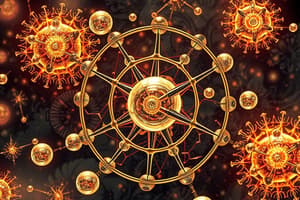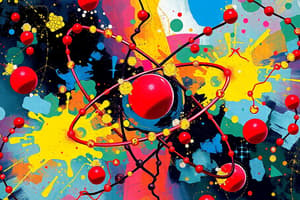Podcast
Questions and Answers
What is one key function of carbohydrates?
What is one key function of carbohydrates?
- Store genetic information
- Insulate organs
- Provide short-term energy (correct)
- Act as hormones
Saturated fatty acids contain double bonds between carbon atoms.
Saturated fatty acids contain double bonds between carbon atoms.
False (B)
What are the three main types of lipids?
What are the three main types of lipids?
Triglycerides, phospholipids, steroids
A buffer is a substance that helps maintain the ______ of a solution.
A buffer is a substance that helps maintain the ______ of a solution.
Match the following terms with their correct definitions:
Match the following terms with their correct definitions:
Which of the following correctly describes ionic and covalent bonds?
Which of the following correctly describes ionic and covalent bonds?
Is the term 'isotope' and 'allotrope' interchangeable in chemistry?
Is the term 'isotope' and 'allotrope' interchangeable in chemistry?
What unique property of carbon allows its atoms to form a large number of different molecules?
What unique property of carbon allows its atoms to form a large number of different molecules?
Substances that do not dissolve in water are considered ______, while those that do dissolve are referred to as ______.
Substances that do not dissolve in water are considered ______, while those that do dissolve are referred to as ______.
Match each biomolecule class with its primary feature:
Match each biomolecule class with its primary feature:
What is the relationship between polymers and monomers?
What is the relationship between polymers and monomers?
Describe the process that produces ADP from ATP.
Describe the process that produces ADP from ATP.
The property of water that allows it to rise through narrow tubes is known as ______.
The property of water that allows it to rise through narrow tubes is known as ______.
Flashcards
Carbohydrate functions
Carbohydrate functions
Carbohydrates primarily provide short-term energy, but also contribute to structural components like cell walls and exoskeletons.
Unsaturated vs. Saturated Fatty Acids
Unsaturated vs. Saturated Fatty Acids
Unsaturated fatty acids have at least one double bond in their hydrocarbon chain, which creates a bend, while saturated fatty acids have only single bonds, making them relatively straight.
DNA vs. RNA
DNA vs. RNA
DNA and RNA are both nucleic acids, composed of nucleotides. DNA uses deoxyribose sugar, while RNA uses ribose sugar. DNA is double-stranded and forms a helix, while RNA is single stranded.
Buffer solution
Buffer solution
Signup and view all the flashcards
Covalent bond
Covalent bond
Signup and view all the flashcards
What is an atom?
What is an atom?
Signup and view all the flashcards
What is an element?
What is an element?
Signup and view all the flashcards
What is a molecule?
What is a molecule?
Signup and view all the flashcards
What is a compound?
What is a compound?
Signup and view all the flashcards
What are ionic bonds?
What are ionic bonds?
Signup and view all the flashcards
What are covalent bonds?
What are covalent bonds?
Signup and view all the flashcards
Are ionic and covalent bonds intermolecular or intramolecular forces?
Are ionic and covalent bonds intermolecular or intramolecular forces?
Signup and view all the flashcards
Why is carbon called the "building block of life"?
Why is carbon called the "building block of life"?
Signup and view all the flashcards
Study Notes
Atomic Structure and Bonding
- Atom: The fundamental unit of matter.
- Element: A substance made of only one type of atom.
- Molecule: A group of two or more atoms bonded together.
- Compound: A substance formed by the chemical combination of two or more different elements.
Subatomic Particles
- Diagram: A simple sketch of an atom with a nucleus containing protons (positive charge, mass ≈ 1 amu) and neutrons (neutral charge, mass ≈ 1 amu). Electrons (negative charge, virtually no mass) orbit the nucleus in electron shells/clouds.
Isotopes vs. Allotropes
- Isotope: Atoms of the same element with different numbers of neutrons, but the same number of protons. They have identical chemical properties
- Allotrope: Different forms of the same element, with different molecular structures. They have different physical properties.
Bonds
- Ionic Bond: Transfer of electrons from one atom to another, forming ions with opposite charges that attract.
- Example: Sodium Chloride (NaCl).
- Covalent Bond: Sharing of electrons between atoms. - Example: Water (H₂O)
- Intramolecular Force: Forces within a molecule. Ionic and covalent bonds are considered intramolecular forces.
- Intermolecular Force: Forces between molecules. (e.g., hydrogen bonds)
Carbon's Uniqueness
- Carbon's ability to form four covalent bonds allows it to form a vast number of complex molecules with diverse structures.
Water Molecule
- Sketch: Represent water molecules as bent shapes with the oxygen atom in the center, bonded to two hydrogen atoms. Show hydrogen bonds between slightly positive hydrogen atoms and slightly negative oxygen atoms of adjacent water molecules. Label partial charges accordingly.
Polar vs. Nonpolar Molecules
- Polar Molecules: Molecules with an uneven distribution of charge, resulting in a positive and negative end (dipole). This is due to differences in electronegativity between atoms within the molecule.
- Nonpolar Molecules: Molecules with an even distribution of charge, no distinct positive or negative end. These typically result from symmetrical bonding of atoms with similar electronegativity.
Dissolving in Water
- Hydrophilic: Substances that dissolve in water. This typically involves polar molecules interacting with water's polar properties.
- Hydrophobic: Substances that do not dissolve in water. This tends to involve nonpolar molecules repelling water molecules.
Properties of Water
- Cohesion: Water molecules stick to each other through hydrogen bonding. (Drawing: Show water molecules close together, connected through hydrogen bonds).
- Adhesion: Water molecules stick to other polar surfaces. (Drawing: Water molecule seemingly clinging to a surface. This would be polar).
- Capillary Action: The ability of water to move against gravity in narrow tubes. (Drawing a tube with water drawn upward. Capillary action would mean narrower tubes would have a greater draw).
- Surface Tension: The resistance to an increase in its surface area. (Drawing: Water molecules drawn close together at the surface resisting the increase in its surface area).
- Specific Heat Capacity: The amount of heat required to raise the temperature of a substance by a certain amount. (Drawing: Water drawing out an external heat source. Water needs more energy to raise the temp.).
Biomolecules
- Carbohydrates: Primary energy source. (Monosaccharides --> Polysaccharides).
- Lipids: Energy storage, insulation, and cell membranes. (Fatty acids + Glycerol --> Triglycerides, Phospholipids, Steroids).
- Proteins: Structural support, enzymes, transport, and defense. (Amino acids --> Polypeptides).
- Nucleic Acids: Storage and transmission of genetic information. (Nucleotides --> DNA and RNA).
Identifying Biomolecule Types
- Diagram Analysis: Look for the presence of specific functional groups, repeating units (monomers), and overall shape.
Monomers and Polymers
- Monomer: A single repeating unit in a polymer.
- Polymer: A large molecule (macromolecule) composed of repeating monomers.
- Carbohydrates: Monomers: monosaccharides (glucose, fructose); Polymers: polysaccharides (glycogen, starch, cellulose).
- Lipids: Monomers: fatty acids and glycerol (in triglycerides); no true repeating monomers.
- Proteins: Monomer: amino acids; Polymer: polypeptide/protein.
- Nucleic Acids: Monomer: nucleotides; Polymer: DNA and RNA.
Polymerization and Depolymerization
- Dehydration Synthesis: Removes water to form a bond between monomers.
- Hydrolysis: Adds water to break a bond between monomers.
ATP and ADP
- ATP (adenosine triphosphate) loses a phosphate group to become ADP (adenosine diphosphate), a process that releases energy.
Carbohydrate Functions
- Carbohydrates provide short-term energy, but also have structural functions (e.g., cellulose in plant cell walls).
Carbohydrates and Lipids
- Similarities: Both are important sources of energy.
- Differences: Carbohydrates are generally hydrophilic; lipids are hydrophobic, making them good for long-term energy storage.
Fatty Acids
- Unsaturated: One or more double bonds between carbon atoms; usually liquid at room temperature.
- Saturated: No double bonds between carbon atoms; usually solid at room temperature.
- Structure-Property Relationship: The presence of double bonds in unsaturated fats creates kinks in the molecule's structure, preventing them from packing tightly together and lowering the melting point.
Lipids - Types
- Triglycerides: Energy storage.
- Phospholipids: Cell membranes.
- Steroids: Hormones and cholesterol
Protein Structure and Function
- Amino Acid Structure: The specific sequence and arrangement of amino acids determine a protein's unique shape and function.
- Organization Levels: Primary (sequence), secondary (alpha-helix or beta-sheet), tertiary (3D folding), and quaternary (multiple polypeptide chains).
Nucleotide Structure
- Sketch: Include a pentose sugar (deoxyribose in DNA, ribose in RNA), a phosphate group, and a nitrogenous base (adenine, thymine, cytosine, guanine or adenine, uracil, cytosine, guanine)
DNA vs. RNA
- Similarities: Both are nucleic acids, composed of nucleotides, and carry genetic information.
- Differences: DNA is double-stranded; RNA is single-stranded, DNA uses thymine; RNA uses uracil, DNA is stable; RNA is more versatile.
DNA Ladder
- Rungs: The nitrogenous bases (A, T, C, G).
Semi-conservative and Antiparallel
- Semi-conservative: Each new DNA molecule consists of one original strand and one new strand.
- Antiparallel: DNA strands run in opposite directions (5' to 3' and 3' to 5').
Acids, Bases, and pH
- pH: Measures the concentration of hydrogen ions (H⁺). Lower pH = more acidic; higher pH = more basic; pH 7 = neutral.
- Ions: Concentration of H⁺ ions determines the acidity or basicity of a solution.
Buffers
- Buffers: Substances that resist changes in pH. They are important in maintaining a stable internal environment in living organisms.
Studying That Suits You
Use AI to generate personalized quizzes and flashcards to suit your learning preferences.




